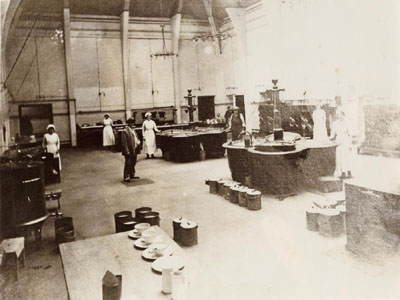
The kitchen and staff at Barnhill Poorhouse, c 1920. The man on the left is the Governor, Alexander Henderson. On the table in the foreground can be seen a bowl, spoon and plate for four inmates.
The food provided at Barnhill was usually adequate in quantity but sometimes lacking in nutritional value. Breakfast might have been porridge, and dinner broth, with potatoes and sometimes cheese. Tea was a luxury often reserved for the elderly. Budget restrictions limited funds available to buy food, but vegetables and fruit grown in the institution's greenhouses supplemented the inmates' diets. Disorderly behaviour would be punished by reducing the amount of food served to the offender at mealtimes.
In 1920 There were sixty-one members of staff at Barnhill (thirty-one women and thirty men) to supervise and care for 2,000 inmates.
Reference: Heatherbank Museum of Social Work, print 972
Reproduced with the permission of Glasgow Caledonian University, Research Collections, Heatherbank Museum of Social Work
Keywords:
Barnhill Poorhouse, cooks, diets, eating, kitchens, nutrition, paupers, poor relief, poorhouse governors, poorhouses, social welfare
You have 0 images in your photo album.